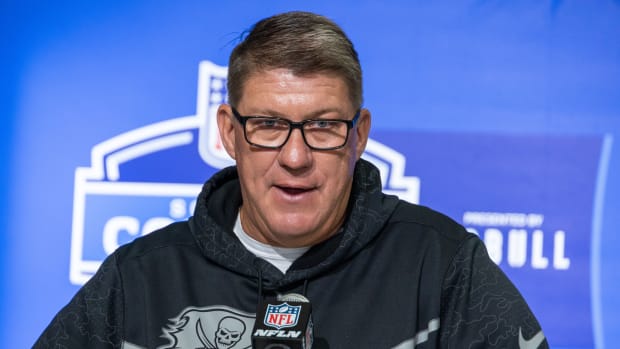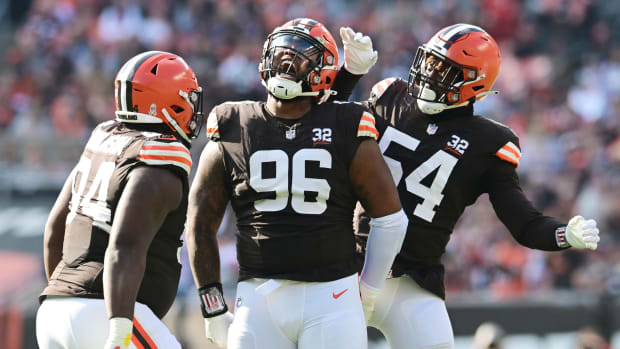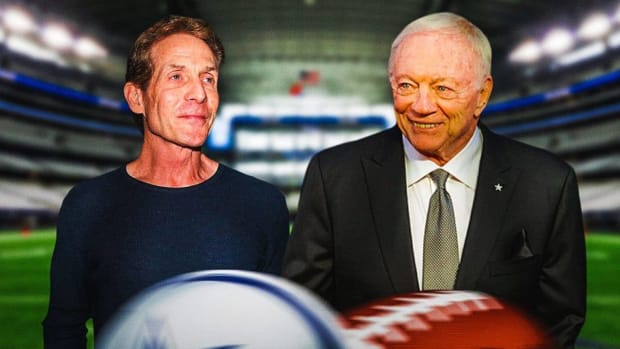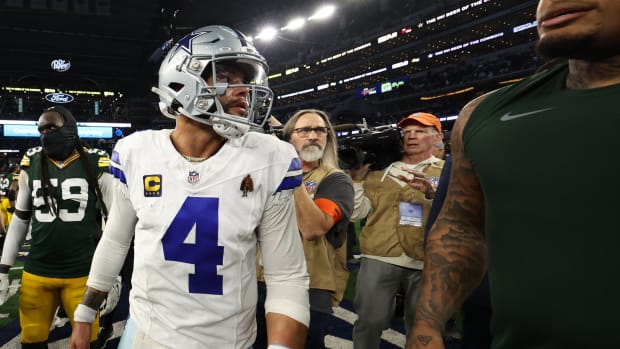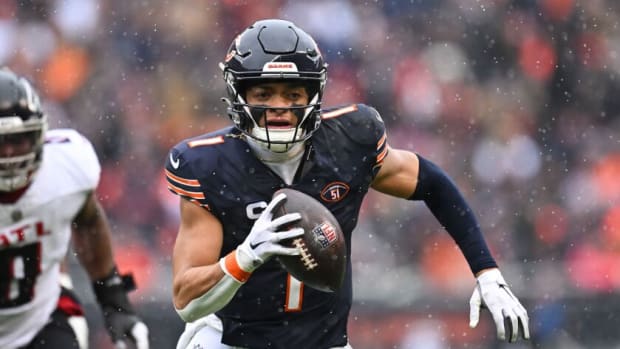For One Afternoon, Cousins Makes Washington Work
There were more than eight minutes remaining in what had been a dreadful first half. Washington quarterback Kirk Cousins, his team down 17-0 at home to an average-at-best Buccaneers club, dropped back to pass out of an empty set. It was a three-step-timing play. With no one else in the backfield to help with protection, and all five eligible receivers spread out wide, it was imperative that Cousins get rid of the ball quickly. Instead, he double-clutched at the top of his drop, taking his left hand off the ball and then placing it back on. The indecisiveness allowed defensive end Jacquies Smith enough time to turn the corner on right tackle Morgan Moses. Smith’s hit on Cousins created a fumble that defensive end Howard Jones scooped up and returned for a touchdown. 24-0 lead for Tampa Bay; same old Kirk Cousins for Washington.
Given Cousins’ history of throwing interceptions when forced to press the ball downfield, or even when compelled to work the deep-intermediate levels, and given Washington’s lack of speed at wide receiver (DeSean Jackson sat a sixth straight game with a hamstring), there might be no NFL team less equipped to come from behind.
But remarkably, that’s precisely what Washington did. The rest of the afternoon belonged to the team’s embattled quarterback and its vastly underappreciated head coach, Jay Gruden.

Cousins went 33 of 40 for 317 yards and three TD passes in leading his team to the biggest comeback in franchise history.
Mark Tenally/AP
Following the Jones fumble return, Gruden dipped into his bag of first down play-action plays. In yet another exhibit to add to the mounting evidence that you don’t actually need to run the ball effectively in order to execute play-action, Cousins, his team trailing by 24 and his runners having posted just 12 yards on seven attempts coming into that drive, faked hand-offs before completing first-down passes to Derek Carrier (six yards) and Ryan Grant (19).
The play-action completions helped set up an eight-yard read-option touchdown for the sluggish but not immobile Cousins. Cutting the deficit to 17 wasn’t enough to stave off boos as Washington trotted to the locker room at halftime, but it was enough to allow Gruden to maintain play-calling balance coming out of it. On their first possession in the second half, Gruden’s offense had the option to continue operating out of base personnel (as opposed to spreading out fulltime with passing personnel). Most of their play-action concepts come out of base personnel, and Gruden continued to feed Cousins those play-actions in the second half.
Play-action helps a quarterback in several ways. For one, because it mostly occurs on early downs and out of base personnel, you’re almost always throwing against a predictable defense. The overwhelming majority of a defense’s coverage disguises and blitzes are found in its nickel and dime sub-packages, not in its standard 4-3. The Bucs, whose zone-based scheme is one of the most vanilla in the league, are no different. Second, play-action naturally cuts a quarterback’s reads in half. Because he must turn his back to the defense in faking the handoff, there’s only time to read either the front or back side of the defense after turning around. Which means either the quarterback hits the primary read downfield or he checks the ball down. Simple. Third, play-action slows down a pass rush, as defensive linemen must invest at least a portion of their energy towards honoring the run. And fourth, teams that play zone and have fast linebackers can be extra liable to play-action, as the fake handoff uses their read-and-react strengths against them. The Bucs have been especially vulnerable to play-action under Lovie Smith. The Titans killed them with it in Week 1 and highs and lows have ensued from there.
Cousins’ strength is hitting the quick in-breaking route, which most of Washington’s play-action centers around. (Deeper-dropping play-action is designed to attack safeties, something Washington does at times but not with great regularity when Jacksons is out of the lineup.)
Washington marched downfield to open the second half and found itself again in the tight red zone. Something else Gruden’s system does extremely well is defeat man coverage with shallow crossing patterns and trips bunches. This was on display on Ryan Grant’s, three-yard touchdown, which made the score 24-14. Following the touchdown, a successful surprise onside kick gave them the ball near midfield, and momentum continued to build. They marched back into the tight red zone. In this part of the field, Gruden loves to call quick slants for either tight end Jordan Reed or stout wide receiver Pierre Garcon. Indeed, he went to this ploy three consecutive times, with Reed scoring on the third.
Just before that play, Reed had caught another quick slant, this time from a wide receiver position on the weak side of the formation. On the strong side, Washington had split out four receivers in a diamond-type quad bunch. There are three main plays that can come from this unconventional 1x4 look: a quick slant for Reed, a fade for Reed or a screen to the four-receiver side.
The 1x4 formation is worth mentioning because on the final drive, after Cousins dinked-and-dunked against a Bucs D that, for reasons unknown, continued to play cushiony off-coverage outside, Reed scored the game-winning six-yard TD off the same play out of the exact same look. Once again, the Bucs failed to defend it. Safety Brad McDougald had Reed bracketed to the outside. Based on simple logic (and backed by the fact that, after the play, the star linebacker buried his head in the turf and then under a towel on the sideline), Lavonte David was presumably supposed to bracket Reed inside. He did not. Quick slant, game over.
David’s mistake might not have mattered. Over on the four-receiver side, there were only three defenders aligned. Cousins could have easily checked to a receiver screen and likely scored an easy touchdown. The final play was a microcosm of the second half: Washington’s offense looked creative and well-coached, Tampa Bay’s defense looked simplistically reactive (and not-so-well-coached). It’s a bad commentary for a defense to get outfoxed by the same play out of the same corky formation in the same part of the field with the game on the line.
After the game, Cousins was excitable. Indeed, the 27-year-old QB played well. He was aided significantly by tremendous game-planning and play-calling, but more important than play-calling is play execution. Hats off to Cousins for coming through.
The narrative, however, could have been very different. Prior to hitting Reed on the game-winner, Cousins fired a dart into a crowded end zone, the ball deflecting out of bounds off safety Chris Conte’s hands. (It wasn’t an easy ball to catch, but Conte will feel even sicker about it when he watches the game film on Monday.) Imagine if Conte had hauled it in. Headlines out of D.C. would have been entirely about Cousins making yet another crucial mistake, this time costing his team the game.
More subtle was what happened early in the second half, just before Ryan Grant’s three-yard touchdown. Cousins again failed to hear his mental alarm clock in the pocket, holding the ball too long and nearly taking a sack that involved him dropping the ball upon getting hit. The play was erased by holding and roughing the passer calls, but imagine if it had gone the other way. It would have been the second time that Cousins’ poor pocket awareness had cost Washington possession and put them on the wrong side of a scoreboard swing.
Alas, Cousins did not pay for those mistakes, and in the second half he had far more positives than negatives. And so the narrative favors him. But without question, the close calls will not be lost on Gruden. He must continue to use shrewd game-planning and play-calling to help—and, for the most part, hide—his quarterback.
































